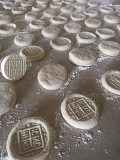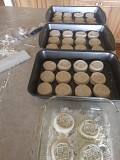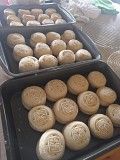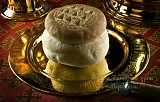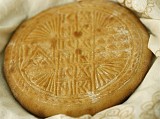...with the baking of communion breads. Here are some photos of small prosphora (pros = forward, phora = bring/brought) that the faithful offer up to God. The faithful write down the names of people living or dead on a piece of paper or a small prayer-list book. The names and a prosphora loaf are taken into the altar where the priest says intercessory prayers for those specified. The ones pictures are about 2 inches in diameter.
The prosphora used for communion of the faithful are much larger, and the quantity per Divine Liturgy varies. In the Greek and Arabic traditions, a single large, round loaf stamped with a large seal (5" and larger seals are common). In the Slavic tradition, five medium-sized loaves are used. The ingredients are the same always: white, unbleached flour (in early Christianity, the most expensive flour by far); water; yeast and in some local traditions, salt. No oils!
There are various spellings for prosphora, and of course various names based on language. The term in Arabic is orban, sometimes seen as urban or kurban. An excellent starting place to learn more, including recipes and how-to's, is www.prosphora.org
Prosphora dough, after it is risen once, is rolled and cut into circles, two per loaf shown here in the Slavic tradition. One is stamped with a seal. On this Russian-style seal, the seal forms the letters IC XC, Jesus Christ's first and last initials in the Greek alphabet, and NIKA, Greek for "victory".
Because of the solemn use for which it is being made--a personal offering to God as part of a prayer request or as the people's sacrificial offering for communion in Divine Liturgy--prosphora is not to be made or treated lightly or casually. Those who bake prosphora receive a blessing from the parish priest. They keep the tools for prosphora baking in a special place; they are set apart for a holy purpose. The baker should proceed in quietness, and be present with this task and this one alone, for the moment.
And oftentimes when prosphora baking is hurried or unfocused, the results are 'coincidentally' not good: sagging breads, indistinct stamp impression, unrisen or very uneven rising, uncooked in the middle, etc. I have baked many and I have learned this the hard way!!! Prosphora baking for a parish is a humbling and also a very prayerful and joyful service.
Finally: after the prosphora have been offered and the priest has prayed for those on the prayer list during the Divine Liturgy, the prosphora are returned to the faithful. The faithful should partake of the now-blessed bread with great piety, taking care that a single crumb does not all astray, and that it is consumed with fasting, not treated as an ordinary food. Some Orthodox Christians keep a number of small particles of prosphora at home and partake of it after their morning prayers, “instead of Holy Communion” throughout the week. In this way, the whole week is sanctified and we continue to participate in the previously-celebrated Liturgy.
This is an example of a Slavic-tradition prosphora, a larger loaf used for communion (photo courtesy of www.classicalChristianity.com)
-Thank you to one of our parish prosphora bakers, for this submission to the website




